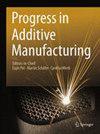Characterisation of print path deviation in material extrusion
IF 5.4
Q2 ENGINEERING, MANUFACTURING
引用次数: 0
Abstract
Abstract Material extrusion, also known as fused filament fabrication, is one of the most popular additive manufacturing techniques due to its lower cost and ease of handling. However, parts produced by material extrusion have relatively poor mechanical performance, dimensional accuracy and thermal performance as compared to parts produced by subtractive manufacturing due to high void content. Previous studies have suggested print path deviation as the cause of these voids, but no attempt has yet been made to characterise these deviations. In this study, we propose a method to assess print path deviation for material extrusion that may reduce the formation of voids in printed parts. Geometric features including straight paths, various angled corners and curves of varying radii are printed at different print speeds using an open-source printer and then imaged under a microscopic. The deviation in print path centroid and width is classified as being a combination of systematic and stochastic deviations. Systematic deviation is determined by the difference between the mean of the actual print path and the ideal print path sent to the printer by the user. Stochastic deviation represents the randomness across print samples and is given by the root mean square deviation. The relationship between stochastic deviation between any two points along the print path is determined by a correlation coefficient. The results show that both print speed and different geometric print features affect the amount of deviation in the print path. In the case of correlation of the stochastic deviation along print paths, geometric features are found to have a much greater effect than print speed. The proposed method provides a low cost and highly transferrable technique to characterise the print path deviation within material extrusion parts with respect to varying printing parameters. An accurate understanding of local print deviations within a part plays a major role in the analysis and topology optimisation of 3D printed parts and gives the ability to assess the print quality and identify the root cause of print deviations, thus reducing voids and improving mechanical performance, dimensional accuracy and thermal properties of the printed part.材料挤压过程中打印路径偏差的表征
摘要材料挤压,也被称为熔融长丝制造,是最流行的增材制造技术之一,由于其较低的成本和易于操作。然而,由于空隙率高,与减法制造相比,材料挤压生产的零件的机械性能、尺寸精度和热性能相对较差。先前的研究表明,打印路径偏差是造成这些空洞的原因,但尚未尝试对这些偏差进行表征。在这项研究中,我们提出了一种方法来评估材料挤压的打印路径偏差,这可能会减少打印部件中空洞的形成。几何特征包括直线路径、各种角度和不同半径的曲线,使用开源打印机以不同的打印速度打印出来,然后在显微镜下成像。打印路径质心和宽度的偏差分为系统偏差和随机偏差的组合。系统偏差是由实际打印路径的平均值与用户发送给打印机的理想打印路径之间的差来确定的。随机偏差表示打印样本的随机性,由均方根偏差给出。打印路径上任意两点的随机偏差之间的关系由相关系数决定。结果表明,打印速度和不同的几何打印特征都会影响打印路径的偏差量。在沿打印路径的随机偏差相关的情况下,发现几何特征比打印速度有更大的影响。所提出的方法提供了一种低成本和高度可转移的技术来表征材料挤压部件内相对于不同的打印参数的打印路径偏差。准确了解零件内部的局部打印偏差在3D打印零件的分析和拓扑优化中起着重要作用,并且能够评估打印质量并确定打印偏差的根本原因,从而减少空隙并提高打印部件的机械性能,尺寸精度和热性能。
本文章由计算机程序翻译,如有差异,请以英文原文为准。
求助全文
约1分钟内获得全文
求助全文
来源期刊

Progress in Additive Manufacturing
Engineering-Industrial and Manufacturing Engineering
CiteScore
7.20
自引率
0.00%
发文量
113
期刊介绍:
Progress in Additive Manufacturing promotes highly scored scientific investigations from academia, government and industry R&D activities. The journal publishes the advances in the processing of different kinds of materials by well-established and new Additive Manufacturing (AM) technologies. Manuscripts showing the progress in the processing and development of multi-materials by hybrid additive manufacturing or by the combination of additive and subtractive manufacturing technologies are also welcome. Progress in Additive Manufacturing serves as a platform for scientists to contribute full papers as well as review articles and short communications analyzing aspects ranging from data processing (new design tools, data formats), simulation, materials (ceramic, metals, polymers, composites, biomaterials and multi-materials), microstructure development, new AM processes or combination of processes (e.g. additive and subtractive, hybrid, multi-steps), parameter and process optimization, new testing methods for AM parts and process monitoring. The journal welcomes manuscripts in several AM topics, including: • Design tools and data format • Material aspects and new developments • Multi-material and composites • Microstructure evolution of AM parts • Optimization of existing processes • Development of new techniques and processing strategies (combination subtractive and additive methods, hybrid processes) • Integration with conventional manufacturing techniques • Innovative applications of AM parts (for tooling, high temperature or high performance applications) • Process monitoring and non-destructive testing of AM parts • Speed-up strategies for AM processes • New test methods and special features of AM parts
 求助内容:
求助内容: 应助结果提醒方式:
应助结果提醒方式:


